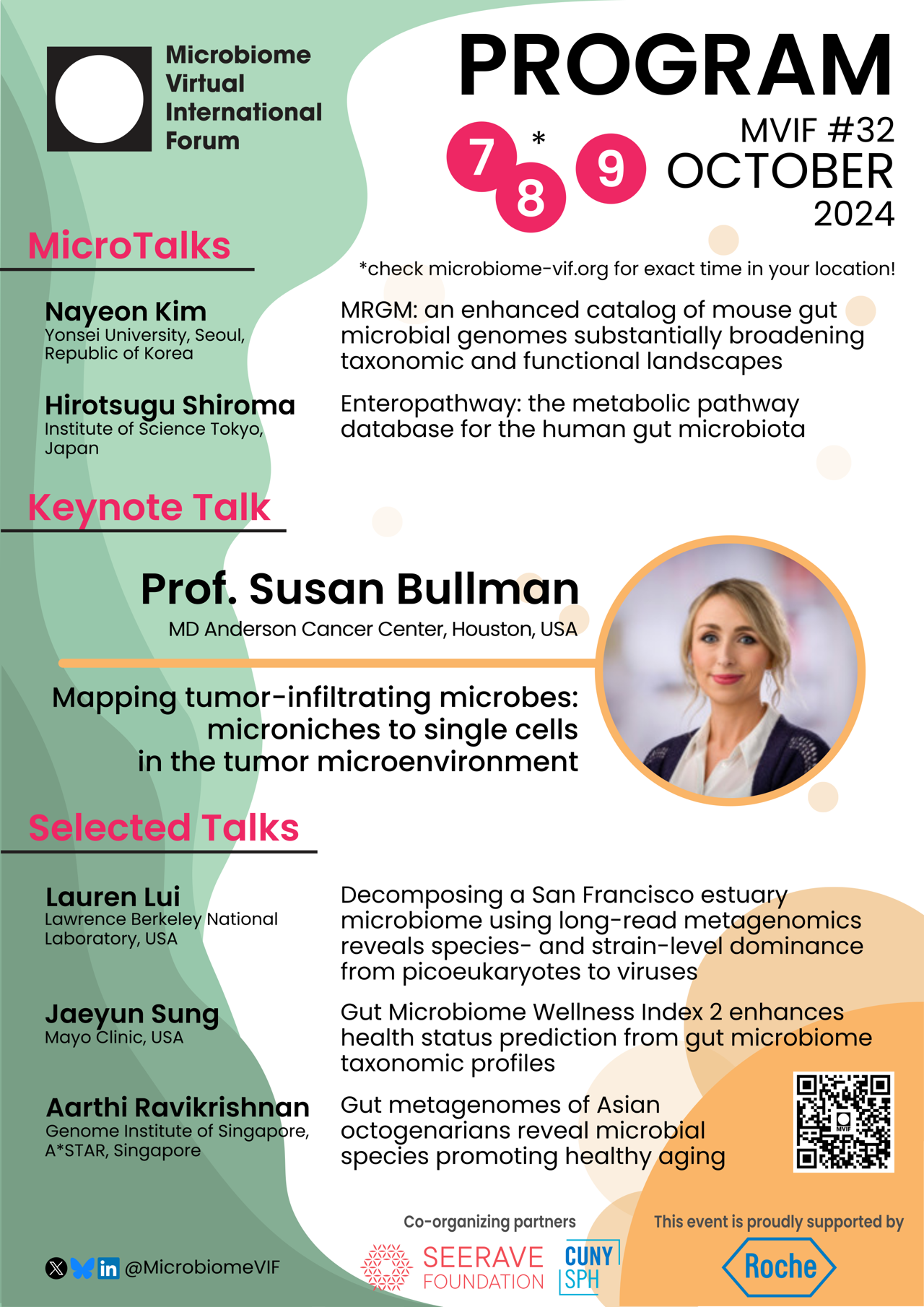Keynote Talk
Mapping tumor-infiltrating microbes: microniches to single cells in the tumor microenvironment
by Prof. Susan Bullman
Within human gastrointestinal tract tumors, malignant cells are surrounded by a complex ecosystem that includes a range of non-transformed human cells, as well as a diverse collection of microorganisms. The goal of my research program is to understand the impact of tumor-infiltrating bacteria on cancer progression and patient response to treatment. My talk will begin by discussing our findings that specific tumor-infiltrating bacteria are an intrinsic component of the colorectal cancer tumor microenvironment, persisting with the cancer even at distant metastatic sites (Bullman et al., Science, 2017).
Additionally, I will highlight our serendipitous findings during the search for a small molecule inhibitor of the oncomicrobe Fusobacterium nucleatum (sensu lato), which revealed a complex interplay between the intratumoral microbiota and cancer treatment drugs (LaCourse et al., Cell Reports, 2022). I will also present our recent efforts to understand the contribution of the intratumoral microbiota to the tumor microenvironment (Galeano Nino et al., Nature, 2022). Specifically, we sought to determine where these microbes physically reside within tumor tissue, what host cells they are interacting with, and most importantly, the consequences of these interactions. To do this, we adapted and applied emerging technologies, including spatial transcriptomics, spatial proteomics, and single-cell sequencing (developed as INVADEseq, Galeano Nino et al., Nature Protocols, 2023), to profile host-microbial interactions in human oral and colorectal cancers. Our results reveal that the intratumoral microbiota is not randomly distributed within human oral and colorectal tumors but instead are localized to distinct microniches associated with immune and epithelial cell functions that support cancer progression.
Finally, I will discuss our recent pangenomic and functional studies on Fusobacterium strains isolated from human colorectal cancer tumors, revealing a distinct Fusobacterium nucleatum (sensu lato) clade that dominates the human colorectal cancer tumor niche (Zepeda-Rivera et al., Nature, 2024). Understanding how the microbiota impacts cancer progression and patient responses to treatment will facilitate the development of novel therapeutic approaches that incorporate the microbial component of the tumor microenvironment.
MicroTalks
MRGM: an enhanced catalog of mouse gut microbial genomes substantially broadening taxonomic and functional landscapes
Mouse gut microbiome research is pivotal for understanding the human gut microbiome, providing insights into disease modeling, host-microbe interactions, and the dietary influence on the gut microbiome. To enhance the translational value of mouse gut microbiome studies, we need detailed and high-quality catalogs of mouse gut microbial genomes. We introduce the Mouse Reference Gut Microbiome (MRGM), a comprehensive catalog with 42,245 non-redundant mouse gut bacterial genomes across 1,524 species. MRGM marks a 40% increase in the known taxonomic diversity of mouse gut microbes, capturing previously underrepresented lineages through refined genome quality assessment techniques. MRGM not only broadens the taxonomic landscape but also enriches the functional landscape of the mouse gut microbiome. Using deep learning, we have elevated the Gene Ontology annotation rate for mouse gut microbial proteins from 3.2% with orthology to 60%, marking an over 18-fold increase. MRGM supports both DNA- and marker-based taxonomic profiling by providing custom databases, surpassing previous catalogs in performance. Finally, taxonomic and functional comparisons between human and mouse gut microbiota reveal diet-driven divergences in their taxonomic composition and functional enrichment. Overall, our study highlights the value of high-quality microbial genome catalogs in advancing our understanding of the co-evolution between gut microbes and their host.
Nayeon Kim, Department of Biotechnology, College of Life Science & Biotechnology, Yonsei University, Seoul, Republic of Korea
Link to OA paper: https://www.tandfonline.com/doi/full/10.1080/19490976.2024.2393791#abstract
Enteropathway: the metabolic pathway database for the human gut microbiota
The human gut microbiota produces diverse, extensive metabolites that have the potential to affect host physiology. Despite significant efforts to identify metabolic pathways for producing these microbial metabolites, a comprehensive metabolic pathway database for the human gut microbiota is still lacking. Here, we present Enteropathway, a metabolic pathway database that integrates 3269 compounds, 3677 reactions, and 876 modules that were obtained from 1012 manually curated scientific literature. Notably, 698 modules of these modules are new entries and cannot be found in any other databases. The database is accessible from a web application (https://enteropathway.org) that offers a metabolic diagram for graphical visualization of metabolic pathways, a customization interface, and an enrichment analysis feature for highlighting enriched modules on the metabolic diagram. Overall, Enteropathway is a comprehensive reference database that can complement widely used databases, and a tool for visual and statistical analysis in human gut microbiota studies and was designed to help researchers pinpoint new insights into the complex interplay between microbiota and host metabolism.
Hirotsugu Shiroma, Institute of Science Tokyo, Japan
Link to OA paper: https://academic.oup.com/bib/article/25/5/bbae419/7747596
Selected Talks
Decomposing a San Francisco estuary microbiome using long-read metagenomics reveals species- and strain-level dominance from picoeukaryotes to viruses
Although long-read sequencing has enabled obtaining high-quality and complete genomes from metagenomes, many challenges still remain to completely decompose a metagenome into its constituent prokaryotic and viral genomes. This study focuses on decomposing an estuarine metagenome to obtain a more accurate estimate of microbial diversity. To achieve this, we developed a new bead-based DNA extraction method, a novel bin refinement method, and obtained 150 Gbp of Nanopore sequencing. We estimate that there are ~500 bacterial and archaeal species in our sample and obtained 68 high-quality bins (>90% complete, <5% contamination, ≤5 contigs, contig length of >100 kbp, and all ribosomal and tRNA genes). We also obtained many contigs of picoeukaryotes, environmental DNA of larger eukaryotes such as mammals, and complete mitochondrial and chloroplast genomes and detected ~40,000 viral populations. Our results suggest there are only a few strains that comprise most of the species abundances from viruses to picoeukaryotes, and to fully decompose a metagenome of this diversity requires 1 Tbp of long-read sequencing. We anticipate that as long-read sequencing technologies continue to improve, less sequencing will be needed.
Lauren Lui, Lawrence Berkeley National Laboratory, USA
Link to OA paper: https://journals.asm.org/doi/full/10.1128/msystems.00242-24
Gut metagenomes of Asian octogenarians reveal microbial species promoting healthy aging
While rapid demographic changes in Asia are driving the incidence of chronic aging-related diseases, the limited availability of high-quality in vivo data hampers our ability to understand complex multi-factorial contributions, including gut microbial, to healthy aging. Leveraging a well-phenotyped cohort of community-living octogenarians in Singapore, we used deep shotgun-metagenomic sequencing for high-resolution taxonomic and functional characterization of their gut microbiomes (n = 234). Joint species-level analysis with other Asian cohorts identified distinct age-associated shifts characterized by reduction in microbial richness, and specific Alistipes and Bacteroides species enrichment (e.g., Alistipes shahii and Bacteroides xylanisolvens). Functional analysis confirmed these changes correspond to metabolic potential expansion in aging towards alternate pathways synthesizing and utilizing amino-acid precursors, vis-à-vis dominant microbial guilds producing butyrate in gut from pyruvate (e.g., Faecalibacterium prausnitzii, Roseburia inulinivorans). Extending these observations to key clinical markers helped identify >10 robust microbial associations to inflammation, cardiometabolic and liver health, including potential probiotic species (e.g., Parabacteroides goldsteinii) and pathobionts (e.g., Klebsiella pneumoniae), highlighting the microbiome’s role as biomarkers and potential targets for promoting healthy aging.
Aarthi Ravikrishnan, Genome Institute of Singapore, A*STAR, Singapore
Link to OA paper: https://www.nature.com/articles/s41467-024-52097-9
Gut Microbiome Wellness Index 2 enhances health status prediction from gut microbiome taxonomic profiles
Recent advancements in translational gut microbiome research have revealed its crucial role in shaping predictive healthcare applications. Herein, we introduce the Gut Microbiome Wellness Index 2 (GMWI2), an enhanced version of our original GMWI prototype, designed as a standardized disease-agnostic health status indicator based on gut microbiome taxonomic profiles. Our analysis involves pooling existing 8069 stool shotgun metagenomes from 54 published studies across a global demographic landscape (spanning 26 countries and six continents) to identify gut taxonomic signals linked to disease presence or absence. GMWI2 achieves a cross-validation balanced accuracy of 80% in distinguishing healthy (no disease) from non-healthy (diseased) individuals and surpasses 90% accuracy for samples with higher confidence (i.e., outside the “reject option”). This performance exceeds that of the original GMWI model and traditional species-level α-diversity indices, indicating a more robust gut microbiome signature for differentiating between healthy and non-healthy phenotypes across multiple diseases. When assessed through inter-study validation and external validation cohorts, GMWI2 maintains an average accuracy of nearly 75%. Furthermore, by reevaluating previously published datasets, GMWI2 offers new insights into the effects of diet, antibiotic exposure, and fecal microbiota transplantation on gut health. Available as an open-source command-line tool, GMWI2 represents a timely, pivotal resource for evaluating health using an individual’s unique gut microbial composition.
Jaeyun Sung, Mayo Clinic, USA
Link to OA paper: https://www.nature.com/articles/s41467-024-51651-9

